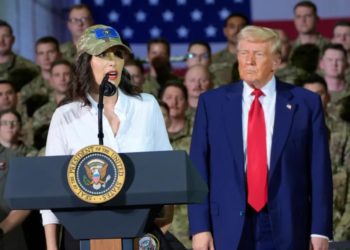Russian President Vladimir Putin’s unilateral announcement of a around the 80th anniversary of World War II ending was met with no applause in Brussels.
“Russia could stop the killing and the bombing at any time. So there’s absolutely no need to wait until the 8th of May,” EU foreign affairs spokesperson Anitta Hipper told reporters on Tuesday.
Critics say the Kremlin — which cites “humanitarian reasons” for its latest truce pledge — is simply trying to curry favor with Washington after US President Donald Trump expressed
Trump’s criticism of Moscow marked a change of tone from the US president’s
Russia’s ceasefire announcement also followed weekend scenes of European leaders huddling with the Ukrainian president and a
With foreign affairs chief Marco Rubio branding this a “critical week,” the US says it’s now mulling whether to quit efforts to broker peace altogether which — some 100 days after Trump took office — are still falling flat.
A tale of two peace plans
As world leaders readied to descend on Rome for the Reuters news agency published two leaks: a ceasefire plan reportedly floated by the US after its talks with Moscow and Kyiv, and a counter-plan drafted by European and Ukrainian officials.
The rival texts show the US and Europe are not on the same pagewhen it comes to conditions for ending the conflict.
While the US-penned document reportedly foresees and “de facto” recognition of some other Ukrainian regions seized by Russia, the European text simply says “territorial issues” should be “resolved after a full and unconditional ceasefire.”
The European-Ukrainian plan also says Ukraine’s military must not be restricted and demands a strong US-backed security guarantee similar to , under which an attack on one member of the military alliance is an attack on all.
The American document seen by Reuters, meanwhile, says Ukraine “will not seek to join NATO” and says only that Ukraine will receive a “robust security guarantee.”
The US would lift sanctions on Russia under its reported plan, while the European text says US sanctions should only be eased “gradually after a sustainable peace is achieved.”
Red lines and reassurance
“What has struck me in recent days is that Europeans are starting to spell out quite clearly what it is that they want,” Camille Grand, an ex-NATO official-turned analyst with the European Council on Foreign Relations, told DW in Brussels.
Grand pointed to weeks of frenetic European diplomacy since Trump took office, with London, Brussels and Rome from top leaders down to military officials working out how European states, led by France and the UK, could police an eventual peace deal in Ukraine through a so-called
“They are seriously talking and they are trying to address each other’s problems: What is it that you miss? Are you ready to go on the ground? No, but can you provide planes? But would you be ready to do so if the force is stationed in Poland?” Grand explained.
“It moved a long way from something which seemed completely disconnected from reality to something where there is a much closer sense of what it is that we are ready to do and how we want to do it.”
European and US officials remain at odds, however, on whether and how Washington would provide a “backstop” to protect European peacekeepers from potential Russian attacks.
Europe wants to keep US and Ukraine talking
Almut Molle, a top analyst with the European Policy Centre think tank, says Europe’s efforts have not gone unnoticed.
“The action to say we are ready to step up, we are here to engage in European security in a very meaningful way is the strongest possible signal to the United States that Europe has understood the call from over the Atlantic,” she told DW in Brussels.
“But does that guarantee a place at the table? No,” she added.
With the US now threatening to leave the table entirely, Europe’s priority may well be to keep Washington on board and willing to listen to Kyiv.
“We’re always stronger together. We’re always stronger with our allies,” the EU’s Anitta Hipper said when pressed by DW on the bloc’s message to the White House.
“Our priority should be to support always Ukraine, because this sends the right message in face of all potential aggressors out there, not only Russia,” Hipper added in a veiled allusion to
Plan B without the US?
But if the US walks away from the negotiating table, it’s hard to imagine a clear Plan B for European countries which regularly pledge to stand with Ukraine “for as long as it takes” without specifying exactly what the “it” looks like.
Financially, the EU could keep up its political and military backing for Ukraine. According to Hipper the bloc has committed some €23 billion ($26.2 billion) worth of assistance to Kyiv so far this year.
But with Ukrainian and European militaries still heavily reliant on US logistics, satellite and intelligence capacity, going it alone is still seen by many in Europe as a worst-case scenario.
Grand thinks the US stepping back from efforts to score a quick deal would be preferable to the open US hostility toward Kyiv epitomized by a
“Compared to that situation, having a US that is less interested, less committed, might not be that big of a drama,” Grand said, adding that Europeans should try to “take advantage of a current moment to see if Trump’s recent admission that Putin might be a problem — not the solution — could help find a better solution.
Edited by: Jess Smee
The post How does Europe want the Ukraine war to end? appeared first on Deutsche Welle.




